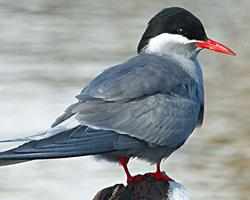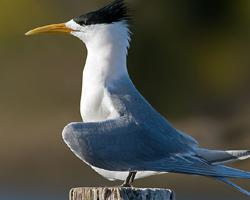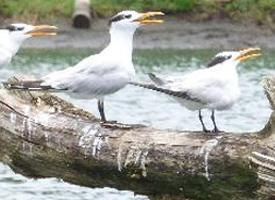
Starea de conservare
| Amenințat |
Descrierea animalului
The Kerguelen Tern (Sterna virgata) is a fascinating and somewhat enigmatic species of seabird belonging to the tern family, Laridae. This slender bird is predominantly known for its isolated breeding grounds, primarily located in the Kerguelen Islands in the southern Indian Ocean, with some populations also found on other subantarctic islands. Its remote habitat contributes to the mystique surrounding this species, as well as the challenges in studying its ecology and behavior comprehensively.Adult Kerguelen Terns are characterized by their sleek profile, with a body length typically ranging between 33 to 35 cm. They possess a relatively slender build, with long, narrow wings and a forked tail that is emblematic of terns. Their plumage is predominantly grey and white, with a striking black cap on their head that extends through the eyes, creating a sharp contrast with their white cheeks and underparts. The bill is slender and pointed, showcasing a vivid red color that adds a dash of vibrancy to their appearance. Their legs and feet are also red, creating a cohesive aesthetic that is both striking and elegant.
One of the most remarkable aspects of the Kerguelen Tern is its foraging behavior. These birds are adept at exploiting the rich marine ecosystems surrounding their island habitats. They primarily feed on small fish and marine invertebrates, which they catch with impressive aerial dives. Flying low over the water, they scan for prey before plunging into the ocean, often submerging completely to snatch their target. This hunting technique showcases their agility and precision, making them a fascinating species to observe.
Breeding season brings another layer of interest to the life cycle of the Kerguelen Tern. They are colonial nesters, choosing to breed in small, scattered colonies on rocky shores or islands, often alongside other seabird species. Nests are typically rudimentary, consisting of shallow scrapes in the ground, which are lined with vegetation and feathers. The female usually lays one to two eggs, which are incubated by both parents. The chicks are semi-precocial, meaning they are relatively mature and mobile from the moment of hatching but still rely on their parents for food and protection.
Despite their remote habitat, Kerguelen Terns face several threats, including climate change, which impacts their breeding success and food availability. Human activities, though limited in their range, can also disturb breeding colonies, leading to reduced reproductive success. Conservation efforts are thus crucial to ensure the survival of this unique species, although their remote habitat does offer some protection from the most direct human impacts.
In summary, the Kerguelen Tern is a remarkable bird, not only for its striking appearance and fascinating foraging and breeding behaviors but also for its ability to thrive in some of the most isolated and inhospitable environments on Earth. Its existence is a testament to the adaptability and resilience of seabirds, and it continues to captivate birdwatchers and researchers fortunate enough to encounter it in the wild.
Animale similare
Fotografii noi cu animale
Top 10 animale
- Dolphin gull (Leucophaeus scoresbii)
- Diana monkey (Cercopithecus diana)
- Moustached guenon (Cercopithecus cephus)
- Stone loach (Barbatula barbatula)
- Greek tortoise (Testudo graeca)
- Galápagos tortoise (Geochelone nigra complex)
- Japanese macaque (Macaca fuscata)
- Russian tortoise (Testudo horsfieldii)
- Common flying dragon (Draco volans)
- Galápagos penguin (Spheniscus mendiculus)


